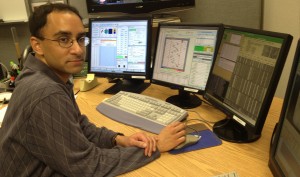Grant to Aid Astronomers in Study of Galaxy Formation
Some California astronomers will be using the Keck Observatory atop Mauna Kea to take a closer look at how galaxies form.
Using a $975,000 grant from the National Science Foundation, the researchers from four universities will be using the MOSFIRE instrument installed last year on the Keck I telescope to survey nearly 2,000 galaxies as they were forming 9 to 12 billion years ago.
MOSFIRE is a spectrograph that analyzes images in infrared light for various chemical signatures.
Observing in the infrared – radiation of heat just beyond what human eyes can detect – allows astronomers to see into cosmic dust clouds and study the most distant objects.
The project involves study of how quickly galaxies are converting their gas into stars, the University of California, Riverside said in a press release. It will also examine how the supernovae of those stars enriched the galaxies with heavier elements such as carbon, nitrogen and oxygen – the stuff of which humans and the Earth are made.
“We will be witnessing the transition from nascent to mature galaxies during the epoch when most of the stars in the universe formed,” said Naveen Reddy, principal investigator of the UCR portion of the grant.

UCR Astronomer Naveen Reddy at work at Keck’s Waimea headquarters this past spring. Photo by Brian Siana/UCR.
“We have a very good picture of what the universe looked like shortly after the Big Bang,” said Bahram Mobasher, another UCR astronomer. “We also have a good picture of what the universe looks like today.
“But what happened in between is less clear. How exactly did the galaxies and stars form? Can we get an accurate estimate of star formation rates in galaxies? And what is the effect of star formation on galaxies? That’s what this survey is about,” Mobasher said. “We’re attempting to connect the dots.”
The astronomers said the speed of the MOSFIRE camera means that measurements that previously took a decade to obtain can now be realized within two months.
The MOSFIRE Deep Evolution Survey got underway this past spring and will be conducted during 47 nights over the next four years.
Also taking part in the survey are astronomers from the Los Angeles, Berkelely and San Diego campuses of the University of California system.













